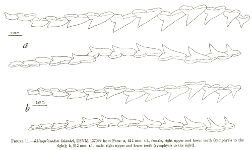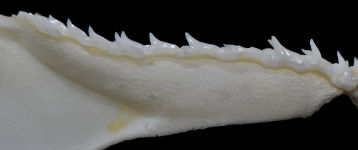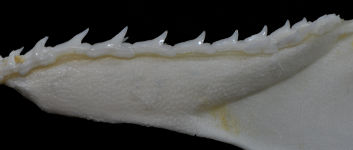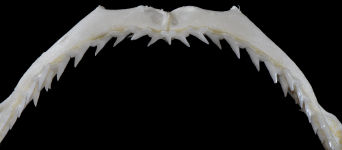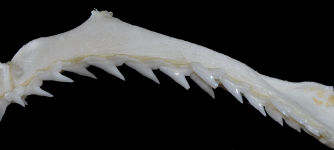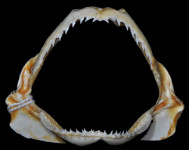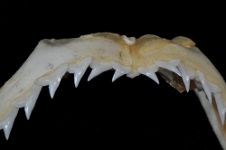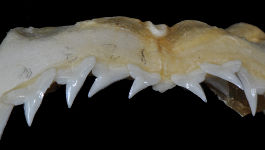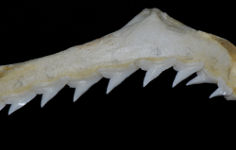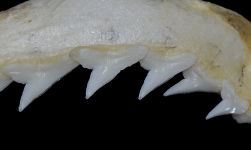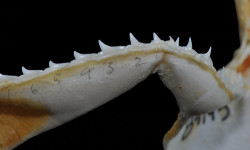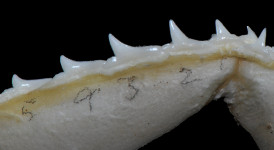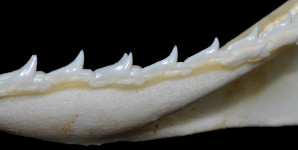Rhizoprionodon lalandii
(Valenciennes in Müller & Henle, 1839)
Brazilian sharpnose shark
Classification: Elasmobranchii Carcharhiniformes Carcharhinidae
Reference of the original description
Systematische Beschreibung der Plagiostomen. Berlin, Veit, pp. 1–200
Systematische Beschreibung der Plagiostomen. Berlin, Veit, pp. 1–200
Image of the original description
No image in first description.
No image in first description.
Synonyms / new combinations and misspellings
Carcharias (Scoliodon) lalandii, Rhizoprionodon lalandei, Rhizoprionodon lalandi, Rhizoprionodon (Protozygaena) lalandei, Scoliodon intermedius, Scoliodon lalandei, Scoliodon lalandi, Scoliodon lalandii, Squalus (Scoliodon) lalandii
Carcharias (Scoliodon) lalandii, Rhizoprionodon lalandei, Rhizoprionodon lalandi, Rhizoprionodon (Protozygaena) lalandei, Scoliodon intermedius, Scoliodon lalandei, Scoliodon lalandi, Scoliodon lalandii, Squalus (Scoliodon) lalandii
Types
Rhizoprionodon lalandii
Lectotype: MNHN: 945; Paralectotype: MNHN: 3467; MNHN: 3466; MNHN: 1143;
Scoliodon intermedius
Lectotype: MCZ: 485-S Paralectotype: MCZ: 484-S
Rhizoprionodon lalandii
Lectotype: MNHN: 945; Paralectotype: MNHN: 3467; MNHN: 3466; MNHN: 1143;
Scoliodon intermedius
Lectotype: MCZ: 485-S Paralectotype: MCZ: 484-S
Description :
Citation: Rhizoprionodon lalandii (Valenciennes in Müller & Henle, 1839): In: Database of modern sharks, rays and chimaeras, www.shark-references.com, World Wide Web electronic publication, Version 01/2026
Please send your images of "Rhizoprionodon lalandii" to info@shark-references.com

Rhizoprionodon lalandii (Müller & Henle, 1839), Size (cm): 44.3 TL, Brazil, Macaé, Rio de Janeiro © Marcelo Vianna, Laboratório de Biologia e Tecnologia Pesqueira, Universidade Federal do Rio de Janeiro

Rhizoprionodon lalandii (Müller & Henle, 1839), Size (cm): 44.3 TL, Brazil, Macaé, Rio de Janeiro © Marcelo Vianna, Laboratório de Biologia e Tecnologia Pesqueira, Universidade Federal do Rio de Janeiro
Common names
 Cazón,
Cazón,  Cazón picudo chino,
Cazón picudo chino,  Tiburón,
Tiburón,  Tollo,
Tollo,  Requin aiguille brésilien,
Requin aiguille brésilien,  Brazilian sharpnose shark,
Brazilian sharpnose shark,  Puppy shark,
Puppy shark,  Shark,
Shark,  Sharpnose shark,
Sharpnose shark,  Cação frango,
Cação frango,  Figuinho,
Figuinho,  Frango
Frango
 Cazón,
Cazón,  Cazón picudo chino,
Cazón picudo chino,  Tiburón,
Tiburón,  Tollo,
Tollo,  Requin aiguille brésilien,
Requin aiguille brésilien,  Brazilian sharpnose shark,
Brazilian sharpnose shark,  Puppy shark,
Puppy shark,  Shark,
Shark,  Sharpnose shark,
Sharpnose shark,  Cação frango,
Cação frango,  Figuinho,
Figuinho,  Frango
Frango
Short Description
Field Marks: In its area the only requiem shark with long upper and lower labial furrows, small second dorsal fin with origin far behind anal origin, long anal ridges, and adpressed pectoral fin apex falling in front of first dorsal midbase. See key to species and diagnostic features for characters separating it from allopatric members of its genus.
Diagnostic Features: Prenarial snout 4.4 to 5.1% of total length; upper labial furrows long, 1.4 to 2.1% of total length; total count of enlarged hyomandibular pores on both sides of head just behind mouth angle usually over 17 (6 to 14 on each side); teeth not serrate or irregularly serrate in adults; adult males with narrower, higher, more flex-cusped anterolateral teeth than adult females or immature males; total tooth rows usually 25/24. First dorsal origin over or slightly posterior to pectoral free rear tips; second dorsal origin usually above anal insertion but occasionally over the rear fourth of its base; pectoral anterior margin usually shorter than first dorsal length from origin to free rear tip; adpressed pectoral apex reaching to below first third of first dorsal base or falling behind it. Posterior monospondylous precaudal centra slightly enlarged; precaudal centra more numerous than caudals, precaudals 79 to 90, total centra 153 to 168. Size moderately small, males maturing at about 50 cm total length. Body dark grey or grey-brown above, light below, pectorals with light margins, dorsals dusky. [517]
Field Marks: In its area the only requiem shark with long upper and lower labial furrows, small second dorsal fin with origin far behind anal origin, long anal ridges, and adpressed pectoral fin apex falling in front of first dorsal midbase. See key to species and diagnostic features for characters separating it from allopatric members of its genus.
Diagnostic Features: Prenarial snout 4.4 to 5.1% of total length; upper labial furrows long, 1.4 to 2.1% of total length; total count of enlarged hyomandibular pores on both sides of head just behind mouth angle usually over 17 (6 to 14 on each side); teeth not serrate or irregularly serrate in adults; adult males with narrower, higher, more flex-cusped anterolateral teeth than adult females or immature males; total tooth rows usually 25/24. First dorsal origin over or slightly posterior to pectoral free rear tips; second dorsal origin usually above anal insertion but occasionally over the rear fourth of its base; pectoral anterior margin usually shorter than first dorsal length from origin to free rear tip; adpressed pectoral apex reaching to below first third of first dorsal base or falling behind it. Posterior monospondylous precaudal centra slightly enlarged; precaudal centra more numerous than caudals, precaudals 79 to 90, total centra 153 to 168. Size moderately small, males maturing at about 50 cm total length. Body dark grey or grey-brown above, light below, pectorals with light margins, dorsals dusky. [517]
Human uses
fisheries: commercial
fisheries: commercial
Biology
Distinct pairing with embrace [17086]. Viviparous, placental [733]. Inhabits shallow coastal waters, on sandy and muddy bottoms, and not normally found in lagoons and estuaries. Feeds on small bony fishes, including sardines and anchovies, also shrimp and squid. Diet:
Distinct pairing with embrace [17086]. Viviparous, placental [733]. Inhabits shallow coastal waters, on sandy and muddy bottoms, and not normally found in lagoons and estuaries. Feeds on small bony fishes, including sardines and anchovies, also shrimp and squid. Diet:
Size / Weight / Age
77 cm TL (female)
77 cm TL (female)
Remarks
shark-references Species-ID=6112;
shark-references Species-ID=6112;
Parasites (arranged by Jürgen Pollerspöck)
Cestoda
Cestoda








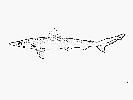
.JPG)
.JPG)
.JPG)
.JPG)
.JPG)
.JPG)
.JPG)
.JPG)
.JPG)
.JPG)
